| |
| The author rejects the European notion of the “Noble Savage” who
lived peacefully in a state of benign nature removed from militaristic
Europeans. “I don’t believe there has ever been an Eden for any length
of time anywhere in the world,’’ LeBlanc said. |
 |
As LeBlanc brilliantly argues, the archaeological record shows that
the warfare and ecological destruction we find today fit into patterns
of human behavior that have gone on for millions of years.
Constant Battles surveys human history in terms of social
organization-from hunter gatherers, to tribal agriculturalists, to more
complex societies.
LeBlanc takes the reader on his own digs around the world -- from New
Guinea to the Southwestern U.S. to Turkey -- to show how he has come to
discover warfare everywhere at every time. His own fieldwork combined
with his archaeological, ethnographic, and historical research, presents
a riveting account of how, throughout human history, people always have
outgrown the carrying capacity of their environment, which has led to
war. |
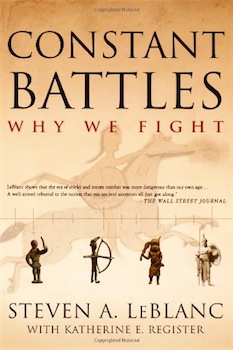 |
| There are ancient petroglyphs, rock engravings and paintings from
around the world, depicting humans fighting with spears, axes and clubs.
About 300,000 years ago when humans first cooked food on a hearth, they
were also using the spears they hunted animals with for killing their
enemies. |
|
Ainu Knife & Sheath w/ Animal Jaw - Japan |
Detail - Maorii Carved Wooden Ceremonial Club - New
Zealand |
War is a persistent attribute of human cultures through time, and
weapons are crafted with a practical, and deadly, intent. Nearly as
pervasive as war itself, is the practice of decorating objects used to
wage it.
What would compel a warrior to deliberately imbue his weapon with beauty
that stands in such stark contrast to its intended purpose? And why are
war objects so much more common and elaborately decorated than those
crafted for peace-making? |
|
Detail/ Carved Wooden Handle of
Dagger w/ Stingray Spines & Obsidian Blade Admiralty Island, Papua
New Guinea |
Maori Whale Bone Club - New Zealand |
| Nearly as universal as war itself has been the inclination to
decorate the weapons of war. People through time and in nearly all
cultures - rich and poor, leaders and followers, foragers in the most
forbidding climates on the planet, and kings of the world’s great
civilizations - have painstakingly embellished their weapons. We may
marvel at their splendor in startling contrast to their deadly purpose,
and we may wonder why we have always felt so compelled to transform
implements of war into objects of surprising beauty. |
|
Knife w/ Copper Blade & Ivory Handle
Tlingit - Northwest Coast of North America |
Detail of Tlingit Knife w/ Copper Blade |
|
Carved Wood Club w/ Whale Teeth
Western Canada |
Detail of a Ceremonial Ax
Democratic Republic of Congo |
Curved Knife w/ Brass Horse Head
Handle
Northern India |
|
James Bond-like Weapon Disguised as
Walking Sticks |
|
Generally, they are single shot
devices although there are a few scarce Pepperbox types
These Pepperboxes tend to be rather bulky in anything but tiny calibers |
|
Cane
Guns are typical of the 19th and early 20th
century and were used by gentlemen to hunt wild game within their
grounds. Quite practical at the time of their manufacture, dapper
gentlemen of the time could combine a de rigueur fashion accessory with
a personal defense firearm. Many villains, thieves, and scoundrels of
the time would perhaps be none the wiser with regard to their intended
victim's ability to defend himself |
|
18th Century |
|
19th Century |
|
As illustrated above, the walking
stick was an implement of fashion in the 18th and 19th centuries.
Gentlemen of wealth and status carried them everywhere and they could
conceal a weapon in plain sight. |
|
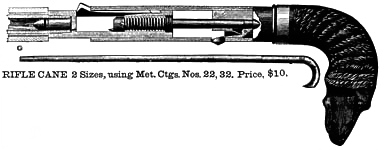
The Remington single-shot "Cane Gun" is unique in several respects,
including its status as the first long arm produced by Remington. In
addition, the arms makers were the only major U.S. firearms firm to
produce such a gun. Manufactured in both percussion and metallic
cartridge versions, the Remington Cane Gun was produced over a
thirty-year span beginning in 1858.
J. F. Thomas, Remington's master mechanic, patented the device in 1858,
and he received a patent extension in 1872. Both patents shared the same
number, and the patent applications were written without specification
as to ignition type. In fact, the same design could be used with either
percussion or metallic cartridge, and this feature ensured Remington's
exclusive rights to U.S. manufacture of cane guns.
Approximately 2,300 of these guns were manufactured, 1,800 of which were
of the .22 or .32 rimfire caliber metallic cartridge design. Percussion
cane guns were offered in .31 and .44 calibers. Gutta percha handles
commonly were of a dog's head, claw-and-ball, golf club, or plain
curved-L variety, and ivory handles were also available. A German silver
ferrule ring adorned the handles of these arms, and the Cane Gun's tip
was typically made from steel. |
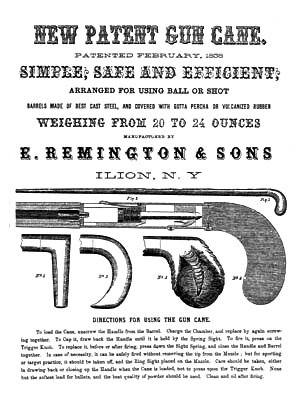 |
|
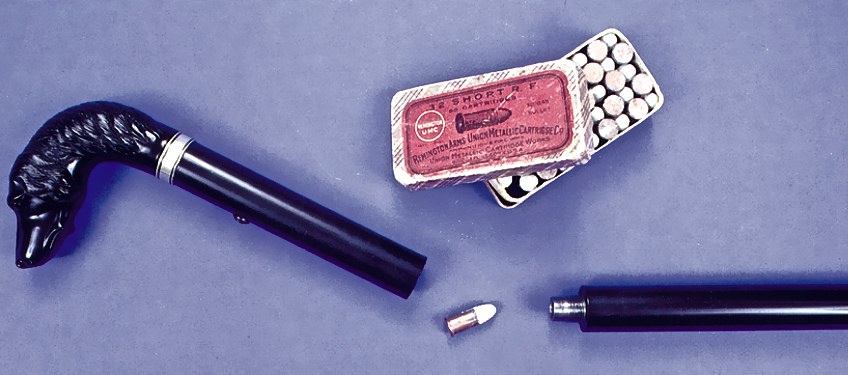 |
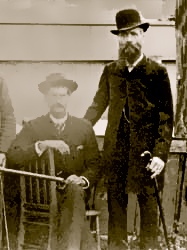 |
|
32 Caliber Cartridge - Rifle Cane |
Gentleman with Remington Cane Gun |
| Everybody has seen sword canes and they were uncommon, but not
unheard of in the Georgian and Victorian eras but gun canes are even
more uncommon than other gadget canes. But as scarce as they were
overall, they were popular with a segment of the population starting in
the 1840s. Slowly over the years, governments put into place laws about
concealed weapons so sword canes and gun canes fell into disfavor and
even outside of the law. |
|
Cased .36-caliber English Cane Gun . . . circa 1849
by E.M. Reilly & Company |
Victorian Gentleman w/Cane |
| Until the 1800s, specialist carvers, metal workers, and artisans
produced canes and walking sticks by hand. However, the popularity of
fashion and gadget canes fueled a market for their mass manufacture and
subsequently helped lead to their demise. Canes became less artistic and
reflective of current fashions. |
|
Is it a Cane? No, it's a Shotgun! |
English Shotgun Sticks / 20 Bore |
|
Cane Gun - Pepperbox w/Spike |
English Cane Guns |
|
Sword Canes - Popular as Weapons
Simple sword canes are far more encountered than projectile
weapons in a cane |
|
Sword Cane Assortment
A “Flicker” Cane in the Center |
Hidden Dagger Cane |
|
Songe Peoples, Democratic
Republic of Congo Central Africa, ceremonial axe, insignia of
rank, wood, iron, and copper |
Nuer Peoples, Sudan, Eastern
Africa
Hippopotamus Hide Shield
Hide and Wood |
Teke Peoples, Ngala Peoples
Congo, Central Africa
Executioner's Sword - Metallic |
Ngombe People, Democratic
Republic of Congo
Shield - Late 19th century
Organic fiber, wood, paint |
|
Rifle Designer Mikhail Kalashnikov - Dead at 94 |
|
MOSCOW — Mikhail Kalashnikov started out wanting to
make farm equipment, but the harvest he reaped was one of blood as the
designer of the AK-47 assault rifle, the world's most popular firearm. |
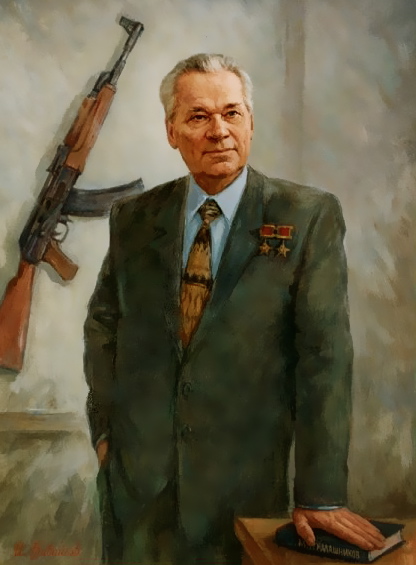 |
It was the carnage of World War II, when Nazi Germany
overran much of the Soviet Union, which altered his course and made his
name as well-known for bloodshed as Smith, Wesson and Colt. The
distinctive shape of the gun, often called "a Kalashnikov," appeared on
revolutionary flags and adorns memorabilia.
Kalashnikov died Januart 23rd, 2013, at age 94 in a hospital in Izhevsk,
the capital of the Udmurtia Republic where he lived. No stated cause of
death. Kalashnikov had been hospitalized for the past month with
unspecified health problems.
Kaslashnikov often said he felt personally untroubled by his
contribution to bloodshed.
"I sleep well. It's the politicians who are to blame for failing to come
to an agreement and resorting to violence," he told The Associated Press
in 2007.
The AK-47 — "Avtomat Kalashnikov" and the year it went into production —
is the world's most popular firearm, favored by guerrillas, terrorists
and the soldiers of many armies. An estimated 100 million guns are
spread worldwide.
Though it isn't especially accurate, its ruggedness and simplicity are
exemplary: it performs in sandy or wet conditions which jam more
sophisticated weapons such as the U.S. M-16.
"During the Vietnam war, American soldiers would throw away their M-16s
to grab AK-47s and bullets for it from dead Vietnamese soldiers,"
Kalashnikov said in July 2007 at a ceremony marking the rifle's 60th
anniversary. |
The weapon's suitability for jungle and desert fighting made it
nearly ideal for the Third World insurgents backed by the Soviet Union,
and Moscow not only distributed the AK-47 widely but also licensed its
production in some 30 other countries.
Kalashnikov was born into a peasant family in Siberia.The moment that
firmly set his course was in the 1941 battle of Bryansk against Nazi
forces, when a shell hit his tank. Recovering from wounds in the
hospital, Kalashnikov brooded about the superior automatic rifles he'd
seen the Nazis deploy; his rough ideas and revisions bore fruit five
years later. "Blame the Nazi Germans for making me become a gun
designer," said Kalashnikov.
In 2007, President Vladimir Putin praised him, saying "The
Kalashnikov rifle is a symbol of the creative genius of our people."
Over his career, he was decorated with numerous honors. But because his
invention was never patented, he didn't get rich off royalties. "At that
time in our country patenting inventions wasn't an issue. We worked for
Socialist society, for the good of the people, which I never regret," he
once said. |
|